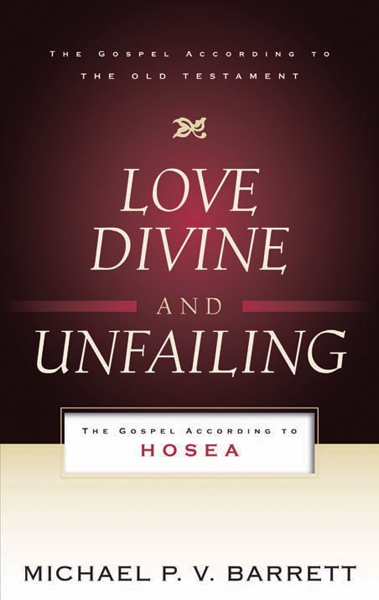
Michael P. V. Barrett
Reviewed by: Clifford L. Blair
Love Divine and Unfailing: The Gospel according to Hosea, by Michael P. V. Barrett. Published by P&R Publishing, 2008. Paperback, 224 pages, list price $12.99. Reviewed by OP pastor Clifford L. Blair.
Michael P. V. Barrett's book on Hosea, Love Divine and Unfailing, is part of P&R's series called The Gospel according to the Old Testament. The series has the excellent goal "to encourage Christ-centered reading, teaching, and preaching of the Old Testament." In keeping with this goal, Barrett's work is not a commentary but "a theological overview of Hosea's message with a view to its gospel application" (p. xx). Those looking for commentaries might consider the works of Douglas Stuart (in the Word series) or Thomas McComiskey (in the three-volume Minor Prophets which he edited) or the more general work by Derek Kidner (in The Bible Speaks Today series).
Barrett's work is presented in three sections and nine chapters, with a conclusion and an appendix dealing with the use of Hosea 11:1 in Matthew 2:15. The book is very readable and does a serviceable job of placing Hosea in the context of the decaying final decades of the (northern) kingdom of Israel. True to his gospel-oriented goal, Barrett clearly emphasizes the redemptive imagery of Hosea's marriage to Gomer (illustrating God's marriage to Israel). In this connection, he gives a helpful survey of interpretations of the difficult command given to Hosea: "Go, take to yourself a wife of harlotry" (Hos. 1:2).
As a pastor reading this book in anticipation of preaching through Hosea, however, I did not find it particularly helpful. It may serve others well, especially someone who has never considered the gospel imagery of election and grace so beautifully portrayed in the relationship of Hosea and Gomer. This message is surely the sweetest fruit to be plucked from Hosea, yet it is low-hanging fruit.
My own wrestling with Hosea had to do with what to make (homiletically) of what Barrett calls the "predominant proportion of Hosea's message … declarations and descriptions of sin" (p. 136). As he observes, "The greater part of Hosea's message addressed the details of Israel's breach of covenant" (p. 126). Hosea's glorious, grace-proclaiming passages are amongst the most beautiful in the Old Testament, but they are few in number and set in a larger, dark context. For the preacher, Hosea may seem like a chain of small, beautiful islands in a vast and forbidding sea. This "predominant proportion" goes largely unaddressed by Barrett, save for a short chapter near the book's end.
This imbalance, frustrating to me, is by all appearances purposeful on the author's part (pp. 98, 165). It may also be wise. The sweet gospel fruit he focuses on is surely the richest part of Hosea and the most needful on first study. Though his work did not address my questions regarding the larger balance of the book, I am happy for all whom the author assists in seeing Christ's gospel in the words of the prophet.
November 30, 2025
November 23, 2025
November 16, 2025
November 09, 2025
November 02, 2025
October 26, 2025
October 19, 2025
© 2025 The Orthodox Presbyterian Church